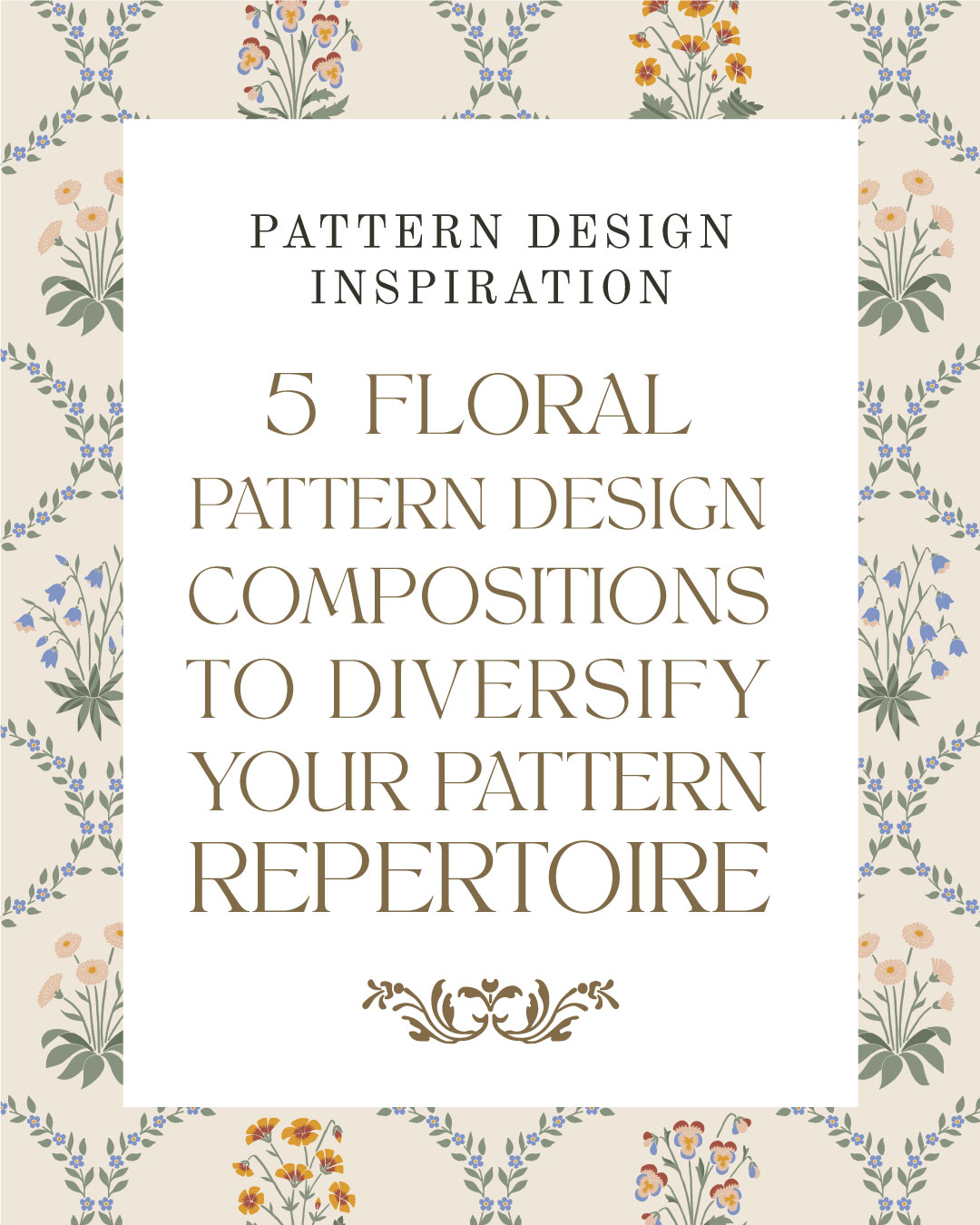5 floral pattern types to diversify your pattern repertoire
Mar 07, 2023
In this article I’m sharing 5 different types of floral patterns you can create to diversify your pattern design repertoire and also the techniques I recommend for creating them.

Flowers are probably the number 1 muse for most surface pattern designers.
But even if it's the most common type of motif to include in patterns there are so many ways that we can create them, just by using different types of compositions and layout structures.
That’s the pattern design inspiration I want to bring you with this article.
5 floral pattern types you can create to broaden your repertoire
1. FLORAL SPOT PATTERNS
 A sprig and a bouquet pattern, by ©Bärbel Dressler. All rights reserved.
A sprig and a bouquet pattern, by ©Bärbel Dressler. All rights reserved.
A floral spot pattern is a sweet, romantic pattern type consisting of simple sprig or bouquet motifs, evenly distributed across the repeat, either in a non-structured (scattered) manner, or in a structured layout (straight, diagonal, half-drop or brick).
My recommended technique: The “collage technique” where you create each motif separately and then duplicate them to create the repeat.
Especially floral sprig patterns can seem simple, if you want a challenge here's how you can vary them:
- Play with spacing, place the sprigs close together or with lots of space in between.
- Alternate between two or several flower motifs, either the same species but drawn differently, alternate between different types of flowers.
- Direction: you can have all motifs face the same direction, or in two or more directions.
2. FLORAL DITSY PATTERNS

Ditsy florals by Liberty London
A ditsy floral pattern has fairly simply drawn flower motifs arranged in a small scale, allover layout where the motifs are intertwining and that makes it almost look like a solid color when looking at it from a distance. The motifs are often arranged in a non directional way that creates lots of flow. A floral ditsy usually has many different flower motifs and leaves.
My recommended technique: The “paper-scissors technique” that allows you to draw the whole design and its motifs all together, which makes it easier to create an even distribution and flow.
3. CONTINUAL FLORAL PATTERNS

Serpentine and trailing Arts and Crafts patterns by Morris
With a continual floral pattern I mean a pattern with floral motifs with stalks or branches that seems to run across the repeat without a visible beginning or end. Examples of continual floral patterns are trailing Arts and Crafts, Indian Floral and Chinoiserie patterns, but can also be more stylized versions with meandering, serpentine branches and stalks.
My recommended technique: The post-it together with the “grid technique”, where you first explore the overall composition and repeat with sticky-notes and then transfer that into a larger, more detailed design using a grid (you can learn this technique in my Trailing Arts and Crafts course on Skillshare).
Ways to vary continual floral patterns:
- With only a few flowers and leaves sprinkled along the stalks/branches
- With lots of flowers and leaves, creating a more dense design
- With a single stalk/branch or forking into side branches
- Use only flower motifs, or also include fruits and birds
4. MIRRORED FLORAL PATTERNS

Mirrored Arts and Crafts floral pattern by John Henry Dearle
A mirrored floral pattern is when you arrange the motifs by reflecting them along a vertical axis. Well, actually two vertical axis. This creates a symmetrical layout. You can create mirrored floral compositions inspired by all kinds of styles; Indian Floral, Arts and Crafts, Art Nouveau, Millefleurs, Mid-century modern just to mention a few.
You can create a more simple composition with separate motifs using the collage technique, or with continual and interlocking motifs as in a Damask.
My recommended techniques: For a simple composition with spacing between the motifs you can use the “collage technique” (see 1. above). For a composition with interlocking motifs you can use the triangle or rhombic techniques, which I share in the Damask course on Skillshare.
5. DIAPER FLORAL PATTERNS

Diaper floral pattern in an ogee structure, by ©Bärbel Dressler. All rights reserved.
You can also arrange your flower motifs inside a diagonal framework, like diagonal trellis, or in an ogee or scallop structure. You can use a very simple framework consisting of simple lines or why not dots, or a more detailed. And inside the framework you arrange your floral motifs.
My recommended technique: The collage technique. Create the flower motifs and the sections for the framework separately. Then piece together the framework elements into grid and place the floral motifs inside them.
I hope this will motivate you to create something new and experiment with pattern composition - and see how you can easily diversify your pattern repertoire of floral designs.
Which one do you want to try out?
